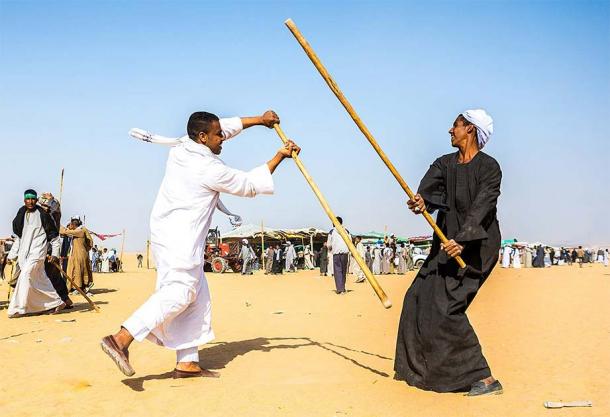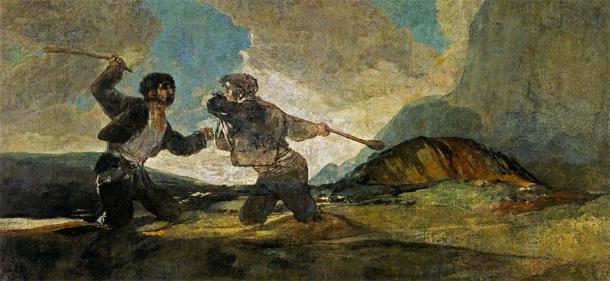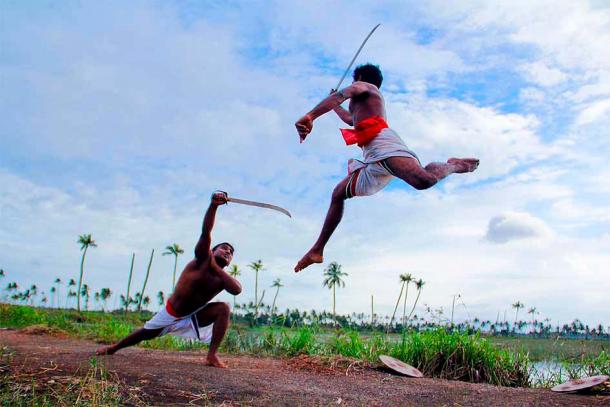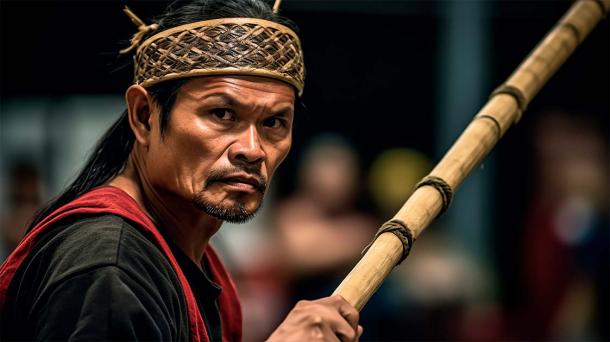The need for self-defense has always been present in history, especially in the ancient world. Sometimes, however, the common folk were not provided with adequate weapons or sufficient training, which greatly reduced their effectiveness in battle. In many cultures, people chose to instruct themselves, and thereby developed unique martial arts that could be very deadly forms of self defense. Many of these martial arts survived through the centuries, being refined and perfected. Here are ten deadly martial arts of the ancient world!
1. Tahtib
Tahtib, also known as Arnis sa Kawayan or simply “stick fighting,” is a traditional martial art that originated in ancient Egypt. Rooted in history and culture, tahtib involves combat techniques using a long bamboo stick as the primary weapon . Practitioners of tahtib engage in choreographed movements that simulate combat scenarios, incorporating strikes, blocks, thrusts and sweeps. The art emphasizes fluid and rhythmic footwork, balance and coordination, making use of the stick as both an offensive and defensive tool.
Tahtib has cultural significance beyond self-defense, often being performed in celebratory events, festivals, and social gatherings. It serves as a means of entertainment, storytelling, and preserving historical heritage. While tahtib’s prominence waned over time, efforts have been made to revive and preserve this ancient art. Modern practitioners study tahtib to connect with Egypt’s martial history, promote cultural appreciation, and foster a sense of community.
Tahtib showcases the ingenuity of ancient Egyptian combat traditions and contributes to a broader understanding of the diversity and depth of martial arts across different cultures.

Men practicing the martial art known as tahtib. (Yasser Elrasoul / CC BY-SA 4.0 )
2. Kung Fu
Kung Fu is a diverse and multifaceted martial arts discipline that originated in China and has gained global recognition. Rooted in ancient traditions, Kung Fu encompasses a vast array of styles, techniques, and philosophies that have evolved over centuries.
Kung Fu techniques include a wide spectrum of strikes, kicks, punches, blocks, joint locks, throws, and more. It emphasizes fluidity of movement, balance, flexibility, and the integration of mind and body, and it can be quite deadly when used in true combat. Many styles are named after animals, imitating their characteristics and movements. Beyond combat, Kung Fu embodies a philosophy of self-discipline, personal development and respect for others. It encompasses principles like harmony, balance and the pursuit of inner peace. Traditional Kung Fu schools often integrate meditation , philosophy and healing practices into their teachings.
The practice of Kung Fu has influenced various aspects of Chinese culture, including literature, theater and film. It gained global popularity in part due to its portrayal in movies and television. Different styles of Kung Fu, such as Shaolin , Wing Chun, Tai Chi and Wushu, showcase its versatility and adaptability to different goals, whether they be self-defense, physical fitness, artistic expression or spiritual growth.
3. Bataireacht
Bataireacht, also known as Irish stick fighting or cudgel play, is a traditional martial art that originated in Ireland. Rooted in the country’s history and culture, bataireacht involves the skilled use of a wooden stick or cudgel for combat.
Practitioners of bataireacht develop proficiency in various techniques, including strikes, blocks, parries and footwork. The art emphasizes fluid movements, precision and timing, making use of the stick as an extension of the body. Bataireacht techniques can be applied in both one-on-one combat and in larger-scale confrontations.
Historically, bataireacht played a role in Ireland’s fight for independence, as well as in everyday self-defense among common people. The art was often practiced covertly due to its association with resistance against British rule. While bataireacht’s prominence waned over time, efforts have been made to preserve and revive its techniques and cultural significance.

Fight with Cudgels by Francisco de Goya, circa 1820, resembles a bataireacht brawl. ( Public domain )
4. Pankration
Pankration was an ancient Greek martial art that emerged in the early Olympics and has left an indelible mark on combat sports history. Combining elements of boxing and wrestling, pankration was a no-holds-barred fighting discipline that allowed for a wide range of techniques, including strikes, joint locks, chokes, and throws.
In pankration, combatants aimed to incapacitate or submit their opponents through a combination of brute force and strategic finesse. Matches could become intense and often ended only when one fighter either surrendered, was rendered unconscious, or was unable to continue. Despite its aggressive nature, there were rules in place to prevent maiming or death.
Pankration was held in high esteem in ancient Greek society, celebrated for its physical prowess and mental fortitude. Its champions were regarded as true all-around athletes, showcasing a blend of strength, agility, and tactical acumen.
Pankration’s legacy can be seen in the modern evolution of mixed martial arts (MMA), as it bears similarities to the diverse combat techniques and versatility displayed in contemporary cage fighting. While pankration itself is no longer widely practiced, its influence endures through its impact on combat sports.
5. Kalaripayattu
Kalaripayattu is an ancient Indian martial art with roots in the state of Kerala. Considered one of the world’s oldest fighting systems, it encompasses a holistic approach to physical, mental, and spiritual development. Kalaripayattu is known for its distinctive blend of striking techniques, weaponry and physical conditioning.
This martial art is divided into various stages of training, beginning with the practice of Meipayattu (body conditioning) to develop flexibility and strength. Kolthari involves training with wooden weapons like staffs, Ankathari introduces metal weapons like knives and swords, and Verumkai focuses on unarmed combat.
Kalaripayattu’s unique techniques include intricate footwork, graceful movements and powerful strikes aimed at vital points on the body. It emphasizes a deep understanding of the body’s energy flow and pressure points for both offense and defense.
Beyond combat, Kalaripayattu incorporates healing techniques, known as Marma Chikitsa, to treat injuries and restore balance. It’s also an essential part of Kerala’s cultural heritage and has influenced other martial arts like Silambam and certain aspects of traditional dance forms.

Two Kalaripayattu swordsmen in mock sword against sword martial arts combat in Kerala. (Phil Bus / CC BY-SA 2.0 )
6. Karate
Karate is a traditional Japanese martial art that originated on the island of Okinawa and later gained worldwide recognition. Characterized by its emphasis on striking techniques using various parts of the body, karate focuses on delivering powerful punches, kicks, knee strikes and elbow strikes. It embodies principles of discipline, respect, and personal development.
Karate practitioners, known as karateka, train in forms (kata), which are choreographed sequences of movements that simulate combat scenarios. These forms help practitioners develop techniques, balance, coordination and mental focus. Karate also includes sparring (kumite), where practitioners engage in controlled, supervised combat to apply techniques in a dynamic setting.
Different styles of karate exist, each with its own philosophy and techniques. Shotokan, Shito-ryu, Goju-ryu, and Wado-ryu are some of the most well-known styles. Karate has been influenced by Okinawan and Chinese martial arts, and it has evolved over time to include both traditional and sport-focused elements.
Karate’s popularity as a martial art, self-defense system and competitive sport has led to its inclusion in international events like the Olympic Games. Beyond physical skills, karate fosters mental resilience, self-confidence and a sense of community.
7. Ninjutsu
Ninjutsu is a historic and secretive Japanese martial art that encompasses a wide range of skills and techniques associated with espionage, sabotage and unconventional warfare. Originating during feudal Japan, ninjutsu was developed and practiced by the ninja, covert agents skilled in espionage and guerrilla tactics.
Ninjutsu encompasses various disciplines, including espionage, disguise, stealth, camouflage, escape, evasion and unconventional combat techniques. Practitioners, known as shinobi or ninja, were trained to operate in a clandestine and covert manner, using their specialized skills to gather information, conduct assassinations and disrupt enemy activities.
The art of ninjutsu places a strong emphasis on adaptability, deception and survival. Techniques include unarmed combat, weapon handling, explosives, poisons and the use of everyday tools as weapons. Additionally, the art includes meditation and mental training to enhance focus, awareness and control.
Ninjutsu’s mystique has been popularized in modern media, though historical records are often limited due to its secretive nature. While the traditional role of the ninja has evolved, the legacy of ninjutsu endures as a symbol of ingenuity, resourcefulness, and the art of adapting to challenging circumstances.
[embedded content]
8. Silambam
Silambam is an ancient martial art hailing from the southern regions of India, particularly Tamil Nadu and Kerala. Rooted in tradition and culture, Silambam revolves around the skillful use of a bamboo staff, also known as silambu or lathi, as a versatile weapon for both offense and defense.
Practitioners of Silambam engage in a dynamic and rhythmic dance-like combat, focusing on fluid movements, footwork and precise strikes. The art incorporates a wide range of techniques, including strikes, blocks, sweeps, thrusts and spins, making it a comprehensive, deadly, and adaptable form of self-defense.
One of Silambam’s distinctive features is its emphasis on weapon-to-weapon combat, as well as unarmed techniques that complement the staff work. The art’s historical roots trace back to ancient battles and warrior traditions, where the silambu was utilized to defend against various opponents and weaponry.
Over time, Silambam has evolved into a cultural expression and a symbol of regional heritage. It has gained recognition as a sport and a means of promoting physical fitness, coordination and discipline. The practice of Silambam continues to be celebrated through performances, competitions and demonstrations, showcasing its significance in preserving the rich martial heritage of South India.
9. Eskrima / Kali / Arnis
Arnis is the national martial art of the Philippines. Also known as Eskrima or Kali, this is a versatile and comprehensive martial art that can be very lethal. This ancient system places a strong emphasis on weapon-based combat, with a primary focus on sticks, blades and improvised weapons. Eskrima practitioners develop a deep understanding of both armed and unarmed techniques, making it effective for self-defense in various scenarios.
Practitioners learn to strike, block, disarm and manipulate opponents’ weapons with precision and speed. The art’s footwork and body positioning contribute to its effectiveness, enabling practitioners to maintain a balanced and controlled approach to combat.
While weapons training is a cornerstone of Eskrima, it also incorporates empty-hand techniques, grappling, and throws, providing a well-rounded self-defense system. The art’s adaptability has led to its integration into modern law enforcement and military training, as well as its continued practice in various cultural and sporting contexts.
Eskrima remains an integral part of the nation’s cultural identity, celebrated for its practicality, efficiency and holistic approach to combat and self-preservation.

Eskrima practitioner wearing a traditional headdress and striking with a stick as part of this unique martial art. ( kian / Adobe Stock)
10. Varma Kalai
Varma Kalai is an ancient martial art and healing system that originated in the region of Tamil Nadu in South India. Rooted in the Siddha tradition, Varma Kalai focuses on the manipulation of vital points ( varma) on the body to both incapacitate opponents and promote healing, depending on the need. This martial art encompasses a wide range of techniques, including strikes, pressure point manipulation, joint locks and weapon-based combat.
Varma Kalai practitioners are trained to target specific points on the body, believed to be interconnected with the body’s energy pathways, nerves, and vital organs. Strikes and pressure applied to these points can disrupt an opponent’s physiological functions, causing pain, paralysis or even death. However, the art also emphasizes the ethical use of its techniques and places great importance on understanding the body’s energy flow and balance.
In addition to combat applications, Varma Kalai includes a comprehensive system of healing and medicine, utilizing the knowledge of vital points to treat injuries, ailments and imbalances in the body. While the ancient art of Varma Kalai has diminished in prominence over time, efforts to preserve and revive its teachings continue, allowing its unique blend of martial prowess and therapeutic knowledge to persist as a cultural and historical treasure.
These ten martial arts, whether showcasing the graceful but lethal moves in Kalaripayattu or the brute force encounters of pankration in ancient Greek arenas, offer a deep dive into the ingenious methods developed for self-defense and warfare. They stand not just as methods of physical combat, but also as spiritual disciplines, philosophies, and influential cultural symbols woven deeply into the tapestries of their respective societies.
Top image: 10 Deadly Martial Arts of the Ancient World. Source: wojciech / Adobe Stock
By Aleksa Vučković
References
DeMarco, M. 2017. Foundations of Korean Martial Arts: Masters, Manuals and Combative Techniques. Via Media Publishing.
Lorge, P. A. 2011. Chinese Martial Arts: From Antiquity to the Twenty-First Century. Cambridge University Press.
Shaw, S. 1998. The Warrior Is Silent: Martial Arts and the Spiritual Path. Simon and Schuster.